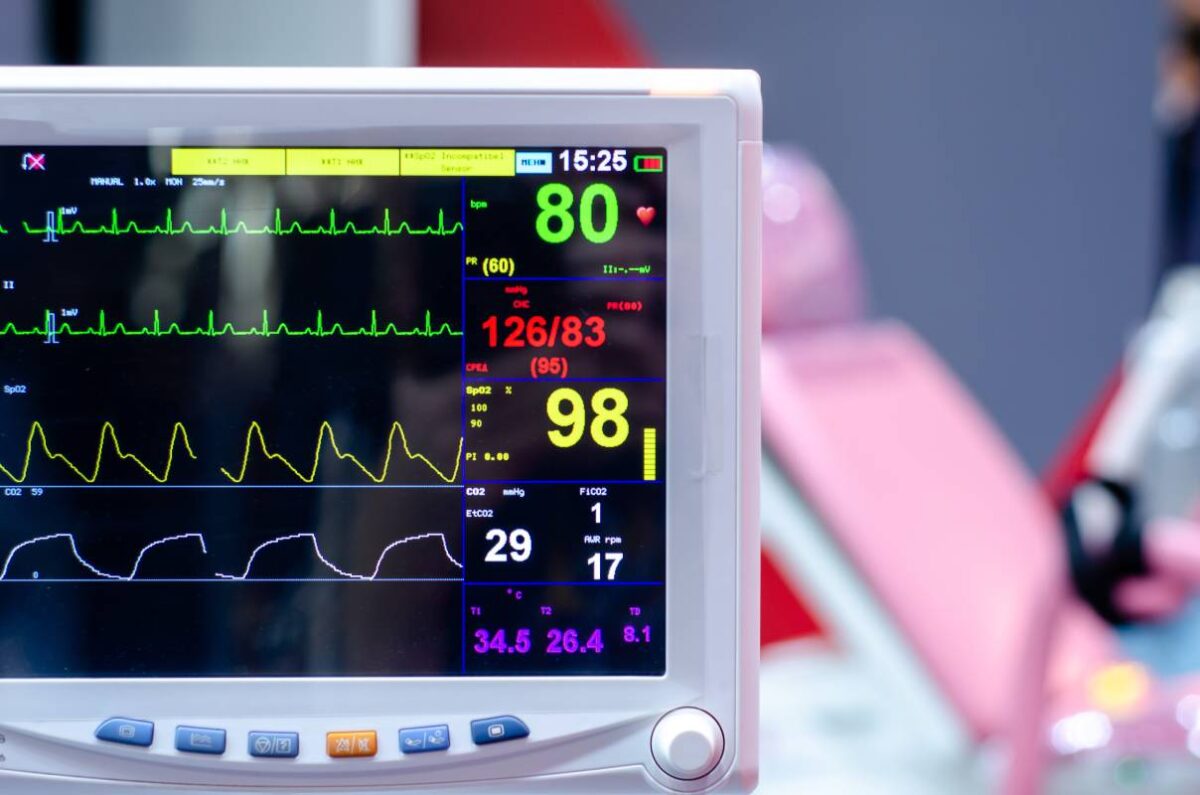End-Tidal CO2 Monitoring During Anesthesia

The American Society of Anesthesiologists standards for basic anesthesia monitoring include measurements of patient oxygenation, ventilation, circulation, and body temperature.1 Measurement of ventilation depends on partial pressure of carbon dioxide, which can be taken by an arterial blood gas measurement. However, since this method is more invasive than other methods, it is not commonly done. A patient’s ventilation is typically observed qualitatively via chest excursion, observation of the breathing bag, and auscultation of breath sounds. Quantitative measurements are measured by proxy via CO2 levels in an anesthesia patient’s exhaled gas, or end-tidal carbon dioxide (ETCO2). ETCO2 can be measured by capnography, capnometry, or mass spectrometry, though the most common method is capnography or capnometry monitored by a machine that has waveforms made up of digital values on a screen and audible end tidal CO2 alarms. Detecting improper ventilation is important as carbon dioxide imbalances can affect acid-base levels in the blood, which may lead to detrimental effects on the patient. End-tidal CO2 monitors can be used to identify improper ventilation earlier so the anesthesia provider can take action to prevent these adverse metabolic outcomes.
There have been many studies demonstrating the efficacy and usefulness of monitoring end-tidal CO2. One study in the 1970s investigated the advantages of end-tidal carbon dioxide monitors, tracking patients who underwent general anesthesia whose procedures had an “event”, defined as any incident that has consequences that can be inferred or predicted, likely to have been harmful to the patient.2 The researchers tracked 2334 anesthesia events, which revealed 79 critical incidents, defined as incidents that were severe enough to warrant the anesthesia provider to intervene. In 58% of events, the anesthesia provider suspected something which the end-tidal CO2 monitor confirmed, either by an abnormal waveform or loss of the waveform entirely. In 27% of the events, the end-tidal CO2 monitor was the initial detector of the incident, leading to provider intervention. These results suggest monitoring end-tidal CO2 is useful for confirmation of the provider’s qualitative observations and as a way to flag potentially harmful events during anesthesia.
With ETCO2 monitoring now being the standard, more studies have come out demonstrating capnography’s situational limitations. A consideration for anesthetic providers is the potential difference in the efficacy of ETCO2 monitoring in general anesthesia versus non-intubated procedural sedation such as during endoscopies and colonoscopies. In a 2017 prospective study, 160 patients were split into 3 groups: procedural sedation, general anesthesia, and awake volunteers, and were monitored with capnography data and a separate Respiratory Volume Monitor.3 With patients that underwent general anesthesia, there was high sensitivity in the minute ventilation and resulting change in ETCO2. For patients that underwent procedural sedation, only half the patients had high ETCO2 sensitivity, with the resulting other patients having low ETCO2 sensitivity. The researchers concluded end-tidal CO2 with capnography is inadequately sensitive in patients undergoing procedural sedation, suggesting anesthesia providers should use an alternate method for monitoring ETCO2 and have increased awareness of hemodynamic changes during these cases.
However, new studies suggest end-tidal CO2 may not be the best way to measure an anesthesia patient’s partial pressure of CO2. In a 2020 study, researchers intraoperatively measured 47 patients’ CO2 via arterial blood gas and compared accuracy to peripheral CO2 measurements like ETCO2, transcutaneous CO2, and capillary blood gas CO2 monitoring.4 The researchers concluded transcutaneous CO2 was the most accurate and reliable measurements of partial pressure of CO2.4
References
- Committee on Standards and Practice Parameters. (2020, December 13). Standards for Basic Anesthetic Monitoring . American Society of Anesthesiologists. Retrieved from https://www.asahq.org/standards-and-guidelines/standards-for-basic-anesthetic-monitoring
- Brown ML. End-tidal carbon dioxide monitoring in the detection of anesthesia-related critical incidents. AANA Journal. 1992;60(1):33-40.
- Mehta JH, Williams GW 2nd, Harvey BC, Grewal NK, George EE. The relationship between minute ventilation and end tidal CO2 in intubated and spontaneously breathing patients undergoing procedural sedation. PLoS One. 2017 Jun 29;12(6):e0180187. doi: 10.1371/journal.pone.0180187. PMID: 28662195; PMCID: PMC5491149.
- May A, Humston C, Rice J, Nemastil CJ, Salvator A, Tobias J. Non-invasive carbon dioxide monitoring in patients with cystic fibrosis during general anesthesia: end-tidal versus transcutaneous techniques. J Anesth. 2020 Feb;34(1):66-71. doi: 10.1007/s00540-019-02706-5. Epub 2019 Nov 7. PMID: 31701307.
